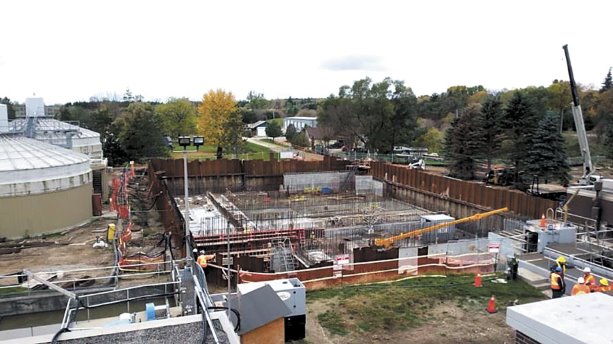Residents on McKeand Street in Ingersoll, Ont. almost have a front row seat on one of the most ambitious, expensive, and environmentally challenging public sector projects ever undertaken in their community.
On the east side of the street on the grounds of the Ingersoll Wastewater Treatment Plant a new conventional activated sludge (CAS) treatment plant is being built by St. Thomas Ontario-based H.I.R.A. Limited.
To be comprised of primarily clarifiers, aeration tanks, secondary clarifiers, and other related systems, it is being erected on the footprint of a now demolished 1947 plant which served Ingersoll on its own until a second one was added in 1974.
The work now being carried out by the general contractor is part of a complex and carefully sequenced two part $18-million upgrade and expansion which commenced in 2014 and won’t be finished until the 2017.
And that’s just the first phase. A second still-to-be designed and awarded second phase estimated at $12.6 million will commence some time afterwards.
Designed to increase treatment capacity from 10,230 to 12,945 m/3 a day, the project is intended to modernize the plant so it can meet future wastewater requirements up to 2035.
Divided into two separate tendered contracts (A and B), with H.I.R.A. winning both, Phase One encompasses several different parts including demolition, new construction, a challenging shoring and dewatering system, and the twinning of the existing outfall into the nearby Thames River.
Intensive design planning and "highly detailed construction sequencing," are required, says Phil Spencer, design engineer, with consultant R.V. Anderson Associates Ltd., which is also assistant contractor administrator for Oxford County which is taking the lead in that role.
An environmental assessment by Oakville, Ont.-based XCG Consultants identifying a number of cost effective, environmental measures to upgrade the plant to so it can meet 2035 capacity requirements was the impetus for the project, says Spence.
In its 2012 report, XCG stated the 1947 plant needed significant mechanical and electrical upgrades, didn’t meet current design standards and was nearing the end "of its useful life."
The preferred alternative selected by the county was to demolish it and replace it with a new CAS Plant and upgrade the 1974 plant with two more secondary clarifiers — for a total of four — says Spence.
But before the original structure could go out of service the 1974 plant improvements had be in place. If that sequencing wasn’t followed, the county would run the or else risk non-compliance during construction period when 1974 plant was operating solo."
There were further complications and hurdles that had to be overcome. The secondary clarifiers couldn’t be installed until an existing bypass sewer and unground primary electrical feed were relocated, says Spence.
In mapping out its design and planning strategy, R. V. Anderson concluded the project had to be divided into two separate contracts, "to minimize construction challenges and maintain optimal operation of the existing facility during construction."
Splitting the construction into two contracts, known as A and B, minimized those challenges and reduced scheduling by about one year, says Spence.
A fast-track approach with "a fairly straight-forward design" was used for implementing Contract A which including installing the additional secondary clarifiers and the relocation of the primary electrical feed. Construction started in 2014 and was completed by the summer of 2015, says Spence.
While the work was proceeding, the much more detailed design for Contract B (the new plant) was being drafted. An intensive process lasting almost a year a half, the design was collaboration between R.V. Anderson’s Toronto and London, Ont. offices.
"This (the design) was a shared responsibility," says Spencer.
That contract, which included demolition of the existing 1947 Plant, construction of the new plant and a sludge thickening facility, plus other works, was awarded to H.I.R.A. in November 2015.
This segment of project has had more than a few challenges. Considerable dewatering is required and early in the schedule the contractor encountered an unexpected snag. A layer of boulders not detected in the original bore hole tests made it impossible for sheet piles to be driven into bedrock.
The solution was to connect the sheet piles to steel H-piles, says Spence.
A critical component of the project is now ongoing test stressing on the 1974 plant — now handling all the flows — to determine if a full 14,250 m3/day-treatment capacity can be achieved once the Phase One expansion and improvement are finished.
If the plant does operate within acceptable limits during this testing period, it will be re-rated and additional aeration would not be required in the Phase Two construction. That would change the scope and cost, says Spence.



Recent Comments
comments for this post are closed